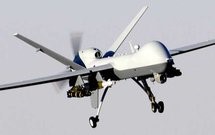 China is rapidly expanding its research into and production, deployments and sales of unmanned aerial vehicles, colloquially known as drones. The primary role of this growing program is to help Beijing control and monitor disputed territories in the Asia-Pacific region.
China is rapidly expanding its research into and production, deployments and sales of unmanned aerial vehicles, colloquially known as drones. The primary role of this growing program is to help Beijing control and monitor disputed territories in the Asia-Pacific region.
Beijing has decided to prioritize its drone program for security and economic reasons. In the security sphere, these machines are very useful for patrolling the East and South China seas, allowing Beijing to maintain a presence in the disputed waters, and play a role in China's anti-access/area denial strategy.
China is developing multiple types of drones, ranging from high-altitude, long-endurance designs like the U.S. Global Hawk to small, hand-launched designs similar to the U.S. Raven. Typically, new Chinese designs are revealed at the Zhuhai Airshow. Chinese companies also have used Zhuhai to demonstrate drones with increased stealth capabilities.
China's equivalent to a Global Hawk, the Soar Eagle, was introduced at Zhuhai in 2006. China already has drones that are comparable to the U.S. Predator and Reaper known as the Yilong/Wing Loong, or "Pterodactyl," and the CH-4. Like the United States, China also has many smaller drones, the most common being the ASN-15.
The United States and Israel are currently the leaders in this technology. While China's drones are not as advanced, tested or capable of the same ranges, they do allow Beijing to monitor its borders and waters more effectively due to extended loiter time. They also help China deter countries from intervening in the area by helping detect and target potential violators of the area they are trying to deny. This is at the heart of the anti-access/area denial strategy and China's motivation for devoting resources to the program. Beijing has plans to build 11 coastal drone bases by 2015 to increase its ability to survey the region for possible intrusions or threats.
Beijing's increased deployment of drones near the disputed Senkaku/Diaoyu Islands has impacted Sino-Japanese relations, prompting Tokyo to expand its own program. Japan is investigating building its own drones and purchasing some from the United States, which Tokyo insists will be unarmed. Reports say the Japanese Defense Ministry hopes to introduce Global Hawks near the disputed islands by 2015 in an attempt to counter Beijing's increasingly assertive naval activity in the area.
Economically, more Chinese drones mean more export opportunities for Beijing. According to some reports, Chinese drones similar to U.S. models are cheaper. China has exported several types to countries including Pakistan and the United Arab Emirates, although Pakistan has also purchased some from the United States. China's best potential markets are countries to which the United States will not sell drones, though such sales would be of concern to Washington -- especially because China has started to sell armed unmanned aircraft. At present, however, the primary role of China's growing program is still to help Beijing monitor territorial waters and control disputed territories in the Asia-Pacific region.
Courtesy : Stratfor (www.stratfor.com)